Dogs
Happy New Year Julie!
Thank you for all that great info about canine noise sensitivity and what can be done. I'm very happy to report my two dogs got through the fireworks without any obvious anxiety this year.
I'm so pleased you raised the topic of laterality in dogs.
You mentioned the work of Dr Nick Branson, who I have been fortunate to work with in our Australian working dog welfare research, along with Professor Paul McGreevy, who we have both mentioned before.
One of Paul's postgraduate students -- Dr Lisa Tomkins -- recently received her PhD after progressing this field of study significantly.
Lisa and I met a few years back when we were studying different Guide Dog populations. I thought I'd tell you briefly about her research and how it connects laterality and working dogs. I also thank Lisa for sending me through some of her images to help in illustrating her work.
It's no mean feat to try and summarise many years of dedicated PhD research without selling it short, but I'll do my best! Lisa looked at a range of physiological, physical and behavioural traits relating to Guide Dog success during the course of her PhD. As part of this, her research uncovered some new and particularly fascinating results regarding the expression of motor, sensory and structural laterality.
First-stepping (Motor)
One of the problems with the Kong™ test (see picture above), that has been used as a benchmark test of laterality, is that hunger and/or motivation to feed can be confounding factors. It can also take up to four hours to collect the requisite 50 observations per dog.
Lisa's research demonstrated that a novel and innovative first-stepping test (that recorded the first foot moving forward after standing still with both forelegs level) overcame the issues of food involvement and proved much quicker, with 50 observations collected in under 20 minutes.
Her results showed a stronger bias demonstration that the previously used Kong™ test and the majority of dogs tested showed a preference to the right (46%), rather than the left (30%) or testing as ambidextrous (24%). This test showed good repeatability and reliability, offering a robust, simple and relatively quick test to measure paw preference, demonstrating motor laterality.
Jumping (Sensory)
Another innovative test developed during Lisa's research was the sensory jump test.
Many variables were recorded, such as launch/landing paw, jump clearance height, approach distance, jump type and success in clearing the obstacle.
But this was not a simple paw preference test. Oh no! It was actually designed to test eye preference in a jumping task, so dogs were tested over the jump 10 times under three different ocular conditions.
The results showed that dogs with the left monocular vision treatment demonstrated significantly compromised jump kinematics on their first jump set. Whereas the right monocular vision treatment dogs performed similarly to the binocular vision dogs.
There was no association between eye preference and motor laterality preferences. This was consistent with findings in primates and horses and indicates that the sensory and motor lateralisation rely on different mechanisms and occur on at least two different levels of neural organisation within the brain.
Hair whorls (Structural)
Hair whorls are a physical feature of hair patterning in the skin that can feature left-right asymmetry. In previous human research, correlations had been demonstrated between hand preference and hair whorls. Studies in other animals (cattle and horses) showed correlations between hair whorls and behavioural traits.
Lisa sought to bring these elements of hair whorls, behaviour and laterality together in her research focussed on Guide Dogs.
As no one had previously looked at hair whorls in dogs, she first had to develop a way to identify and measure the hair whorls found in dogs. She located positions where most dogs showed hair whorl patterning and in which population trends for direction (clockwise vs. counter-clockwise) were evident.
Further research showed the first evidence of an association between structural asymmetry (the presence and direction of hair whorls) and sensory lateralisation (the sensory jump test). There was also an association found between structural and motor (paw preference) laterality.
Interestingly, dogs with clockwise chest whorls were more likely to be 'right-pawed'.
Oasis - Wonderwall (or was it actually always Wonder-whorl?!)
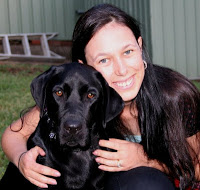
Prefer to watch it?
For a really neat (<7min) summation of most of Lisa's PhD research,
check out this great short clip from the Australian ABC's national science program, Catalyst:
click here
Pretty amazing stuff, right?
How is Project: Play with your Dog going over at the Horowitz Canine Cognition Lab?
I have to organise for someone to come with me next time I head to the river to play with my dogs. We've got a week of super hot weather ahead of us, so chances are very high that I'll be submitting a video soon!
I have to get back to researching a new topic now...
but I'll tell you all about that next time!
Mia
Further reading:
Tomkins L.M., Thomson P.C. & McGreevy P.D. (2010). First-stepping Test as a measure of motor laterality in dogs (Canis familiaris), Journal of Veterinary Behavior: Clinical Applications and Research, 5 (5) 247-255. DOI: 10.1016/j.jveb.2010.03.001
Tomkins L.M., Williams K.A., Thomson P.C. & McGreevy P.D. (2010). Sensory Jump Test as a measure of sensory (visual) lateralization in dogs (Canis familiaris), Journal of Veterinary Behavior: Clinical Applications and Research, 5 (5) 256-267. DOI: 10.1016/j.jveb.2010.02.005
Tomkins L.M. & McGreevy P.D. (2010). Hair Whorls in the Dog (Canis familiaris). I. Distribution, The Anatomical Record: Advances in Integrative Anatomy and Evolutionary Biology, 293 (2) 338-350. DOI: 10.1002/ar.21055
Tomkins L.M. & McGreevy P.D. (2010). Hair Whorls in the Dog (Canis familiaris), Part II: Asymmetries, The Anatomical Record: Advances in Integrative Anatomy and Evolutionary Biology, 293 (3) 513-518. DOI: 10.1002/ar.21077
Tomkins L.M., Thomson P.C. & McGreevy P.D. (2011). Behavioral and physiological predictors of guide dog success, Journal of Veterinary Behavior: Clinical Applications and Research, 6 (3) 178-187. DOI: 10.1016/j.jveb.2010.12.002
Tomkins L.M., Williams K.A., Thomson P.C. & McGreevy P.D. (2012). Lateralization in the domestic dog (Canis familiaris): Relationships between structural, motor, and sensory laterality, Journal of Veterinary Behavior: Clinical Applications and Research, 7 (2) 70-79. DOI: 10.1016/j.jveb.2011.07.001
Tomkins L.M., Thomson P.C. & McGreevy P.D. (2012). Associations between motor, sensory and structural lateralisation and guide dog success, The Veterinary Journal, 192 (3) 359-367. DOI: 10.1016/j.tvjl.2011.09.010
© Mia Cobb 2012
- Don't Miss Out! Dogs + Science From November
Catch up! Participate! Plan your conferences for 2015! Check out all the latest in canine science from November here, thanks to the magic of Storify (if you don't see a beautiful array of handy snippets below, please click this link to view) [View...
- Canine Science Catch Up: 16-30 September 2014
Gosh, it's been a busy ride since posting the excellent guest post by research, Cat Reeve, about her interesting detector dog research. So now it's time to play catch up, starting with the canine science related things that we noticed...
- Igniting Sparks, Surviving Fireworks And Dog Science July!
Hey Julie, well, here I am, back in chilly, wintry Melbourne. #SPARCS2014 was an amazing event - such an intense three days with early feedback suggesting over 40,000 people joined in online for canine science, excitement, wonderful researchers...
- Canines And Castles: 4th Canine Science Forum Abstract & Early Bird Registration Deadline Friday
“Two canine scientists, Julie Hecht and Mia Cobb, met briefly at a conference in Barcelona in late July 2012. They share a passion for canine science, good communication, social media and fun.” So reads the 'About' page at Do You Believe...
- What Kinds Of Dogs Are Troubled By Fireworks, And What To Do About It
Hi Mia, I agree with you. As much as I enjoy New Years celebrations, it breaks my heart to see so many dogs distressed over our reverie. (Source) Which dogs are troubled by noises? As you say, some dogs are la-di-da about fireworks and others act...
Dogs
Thinking laterality: steps, jumps and wonder-whorls
Happy New Year Julie!
Thank you for all that great info about canine noise sensitivity and what can be done. I'm very happy to report my two dogs got through the fireworks without any obvious anxiety this year.
I'm so pleased you raised the topic of laterality in dogs.
 |
| Left paw preference - right paw preference - welcome to laterality! (source) |
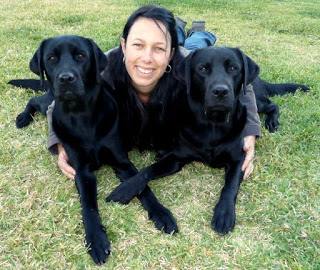 |
| Dr Lisa Tomkins |
One of Paul's postgraduate students -- Dr Lisa Tomkins -- recently received her PhD after progressing this field of study significantly.
Lisa and I met a few years back when we were studying different Guide Dog populations. I thought I'd tell you briefly about her research and how it connects laterality and working dogs. I also thank Lisa for sending me through some of her images to help in illustrating her work.
It's no mean feat to try and summarise many years of dedicated PhD research without selling it short, but I'll do my best! Lisa looked at a range of physiological, physical and behavioural traits relating to Guide Dog success during the course of her PhD. As part of this, her research uncovered some new and particularly fascinating results regarding the expression of motor, sensory and structural laterality.
First-stepping (Motor)
One of the problems with the Kong™ test (see picture above), that has been used as a benchmark test of laterality, is that hunger and/or motivation to feed can be confounding factors. It can also take up to four hours to collect the requisite 50 observations per dog.
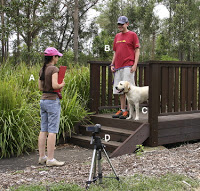 |
| All set to step (source) |
Lisa's research demonstrated that a novel and innovative first-stepping test (that recorded the first foot moving forward after standing still with both forelegs level) overcame the issues of food involvement and proved much quicker, with 50 observations collected in under 20 minutes.
Her results showed a stronger bias demonstration that the previously used Kong™ test and the majority of dogs tested showed a preference to the right (46%), rather than the left (30%) or testing as ambidextrous (24%). This test showed good repeatability and reliability, offering a robust, simple and relatively quick test to measure paw preference, demonstrating motor laterality.
 |
| The first-step test in action (source) |
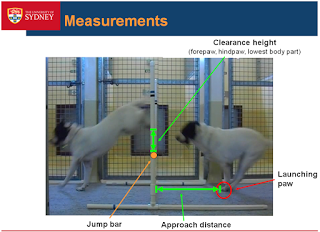 |
| source: Dr Lisa Tomkins |
Many variables were recorded, such as launch/landing paw, jump clearance height, approach distance, jump type and success in clearing the obstacle.
But this was not a simple paw preference test. Oh no! It was actually designed to test eye preference in a jumping task, so dogs were tested over the jump 10 times under three different ocular conditions.
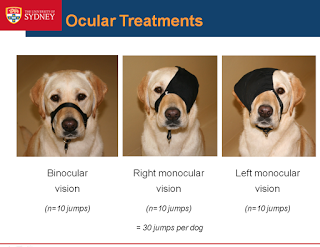 |
| source: Dr Lisa Tomkins |
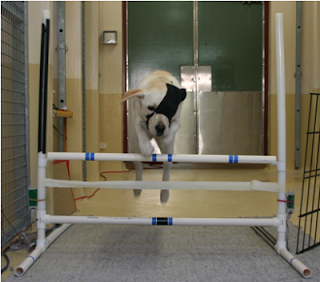 |
source: Dr Lisa Tomkins |
The results showed that dogs with the left monocular vision treatment demonstrated significantly compromised jump kinematics on their first jump set. Whereas the right monocular vision treatment dogs performed similarly to the binocular vision dogs.
There was no association between eye preference and motor laterality preferences. This was consistent with findings in primates and horses and indicates that the sensory and motor lateralisation rely on different mechanisms and occur on at least two different levels of neural organisation within the brain.
Hair whorls (Structural)
Hair whorls are a physical feature of hair patterning in the skin that can feature left-right asymmetry. In previous human research, correlations had been demonstrated between hand preference and hair whorls. Studies in other animals (cattle and horses) showed correlations between hair whorls and behavioural traits.
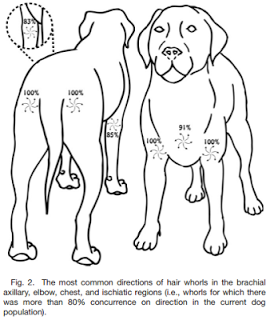 |
| Where does your dog whorl? (source) |
As no one had previously looked at hair whorls in dogs, she first had to develop a way to identify and measure the hair whorls found in dogs. She located positions where most dogs showed hair whorl patterning and in which population trends for direction (clockwise vs. counter-clockwise) were evident.
Further research showed the first evidence of an association between structural asymmetry (the presence and direction of hair whorls) and sensory lateralisation (the sensory jump test). There was also an association found between structural and motor (paw preference) laterality.
Interestingly, dogs with clockwise chest whorls were more likely to be 'right-pawed'.
Oasis - Wonderwall (or was it actually always Wonder-whorl?!)
Powered by mp3skull.com
 |
| Arrows added by me to highlight the directionality of whorls (source) |
What does it mean?

Dr Lisa Tomkins' research has provided fellow researchers with important insight into the different expressions of motor, structural and sensory lateralisation in domestic dogs. She has certainly added significantly to the landscape for future work in this area of study.
The expressions of laterality investigated have demonstrated associations that relate to behavioural traits that can determine/predict Guide Dog success.
Lisa's research determined that dogs with a significantly increased likelihood of Guide Dog training success demonstrated:
- Right-paw preference,
- Demonstrated shift toward left monocular vision bias and greater hindpaw clearance height in the sensory jump test, and
- Counter-clockwise chest whorl
This has implications relevant to the working dog industry.
These objective measures of features present from an early age (especially physical traits like hair whorls) could prove helpful in identifying dogs most likely to succeed at Guide Dog work, improving the efficiency of programs dedicated to producing working dogs.
Prefer to watch it?
For a really neat (<7min) summation of most of Lisa's PhD research,
check out this great short clip from the Australian ABC's national science program, Catalyst:
click here
 |
| (source) |
How is Project: Play with your Dog going over at the Horowitz Canine Cognition Lab?
I have to organise for someone to come with me next time I head to the river to play with my dogs. We've got a week of super hot weather ahead of us, so chances are very high that I'll be submitting a video soon!
I have to get back to researching a new topic now...
but I'll tell you all about that next time!
Mia
Further reading:
Tomkins L.M., Thomson P.C. & McGreevy P.D. (2010). First-stepping Test as a measure of motor laterality in dogs (Canis familiaris), Journal of Veterinary Behavior: Clinical Applications and Research, 5 (5) 247-255. DOI: 10.1016/j.jveb.2010.03.001
Tomkins L.M., Williams K.A., Thomson P.C. & McGreevy P.D. (2010). Sensory Jump Test as a measure of sensory (visual) lateralization in dogs (Canis familiaris), Journal of Veterinary Behavior: Clinical Applications and Research, 5 (5) 256-267. DOI: 10.1016/j.jveb.2010.02.005
Tomkins L.M. & McGreevy P.D. (2010). Hair Whorls in the Dog (Canis familiaris). I. Distribution, The Anatomical Record: Advances in Integrative Anatomy and Evolutionary Biology, 293 (2) 338-350. DOI: 10.1002/ar.21055
Tomkins L.M. & McGreevy P.D. (2010). Hair Whorls in the Dog (Canis familiaris), Part II: Asymmetries, The Anatomical Record: Advances in Integrative Anatomy and Evolutionary Biology, 293 (3) 513-518. DOI: 10.1002/ar.21077
Tomkins L.M., Thomson P.C. & McGreevy P.D. (2011). Behavioral and physiological predictors of guide dog success, Journal of Veterinary Behavior: Clinical Applications and Research, 6 (3) 178-187. DOI: 10.1016/j.jveb.2010.12.002
Tomkins L.M., Williams K.A., Thomson P.C. & McGreevy P.D. (2012). Lateralization in the domestic dog (Canis familiaris): Relationships between structural, motor, and sensory laterality, Journal of Veterinary Behavior: Clinical Applications and Research, 7 (2) 70-79. DOI: 10.1016/j.jveb.2011.07.001
Tomkins L.M., Thomson P.C. & McGreevy P.D. (2012). Associations between motor, sensory and structural lateralisation and guide dog success, The Veterinary Journal, 192 (3) 359-367. DOI: 10.1016/j.tvjl.2011.09.010
© Mia Cobb 2012
- Don't Miss Out! Dogs + Science From November
Catch up! Participate! Plan your conferences for 2015! Check out all the latest in canine science from November here, thanks to the magic of Storify (if you don't see a beautiful array of handy snippets below, please click this link to view) [View...
- Canine Science Catch Up: 16-30 September 2014
Gosh, it's been a busy ride since posting the excellent guest post by research, Cat Reeve, about her interesting detector dog research. So now it's time to play catch up, starting with the canine science related things that we noticed...
- Igniting Sparks, Surviving Fireworks And Dog Science July!
Hey Julie, well, here I am, back in chilly, wintry Melbourne. #SPARCS2014 was an amazing event - such an intense three days with early feedback suggesting over 40,000 people joined in online for canine science, excitement, wonderful researchers...
- Canines And Castles: 4th Canine Science Forum Abstract & Early Bird Registration Deadline Friday
“Two canine scientists, Julie Hecht and Mia Cobb, met briefly at a conference in Barcelona in late July 2012. They share a passion for canine science, good communication, social media and fun.” So reads the 'About' page at Do You Believe...
- What Kinds Of Dogs Are Troubled By Fireworks, And What To Do About It
Hi Mia, I agree with you. As much as I enjoy New Years celebrations, it breaks my heart to see so many dogs distressed over our reverie. (Source) Which dogs are troubled by noises? As you say, some dogs are la-di-da about fireworks and others act...
